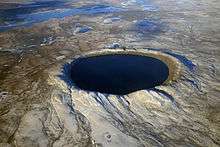Santa Marta crater
Santa Marta crater is a newly confirmed impact crater in Piauí State, northeastern Brazil.[1] It is 10 kilometres (6.2 mi) in diameter and it is estimated to have formed between 100 and 66 Ma, during the Late Cretaceous.
 Location of the crater in Brazil | |
| Impact crater/structure | |
|---|---|
| Confidence | Confirmed |
| Diameter | 10 km (6.2 mi) |
| Age | ~66-100 Ma Late Cretaceous |
| Exposed | Yes |
| Drilled | No |
| Location | |
| Location | Parnaíba Basin |
| Coordinates | 10°10′S 45°15′W |
| Country | Brazil |
| State | Piauí |
Description
Its impact origin was first proposed by S. Master and J. Heymann in 2000 based primarily on satellite remote sensing data[2] and was confirmed more than a decade later after conclusive evidence of shock metamorphism such as breccia and shatter cones were found.[3]
gollark: *earthquake might also do that*
gollark: *kind of*
gollark: *so vampires are just a convoluted mechanic for abandoning eggs early?*
gollark: *what*
gollark: Blued and plorange.
See also
References
- "Santa Marta". Earth Impact Database. Planetary and Space Science Centre University of New Brunswick Fredericton. Retrieved 2017-10-09.
- Master, S.; Heymann, J (2000). A Possible New Impact Structure near Gilbués in Piauí Province, Northeastern Brazil, Meteoritics & Planetary Science, vol. 35, Supplement, p.A105
- A. P. Crósta and M. A. Vasconcelos (2013). Confirmation Of The Impact Origin Of The Santa Marta Crater, Brazil, 76th Annual Meteoritical Society Meeting
This article is issued from Wikipedia. The text is licensed under Creative Commons - Attribution - Sharealike. Additional terms may apply for the media files.

